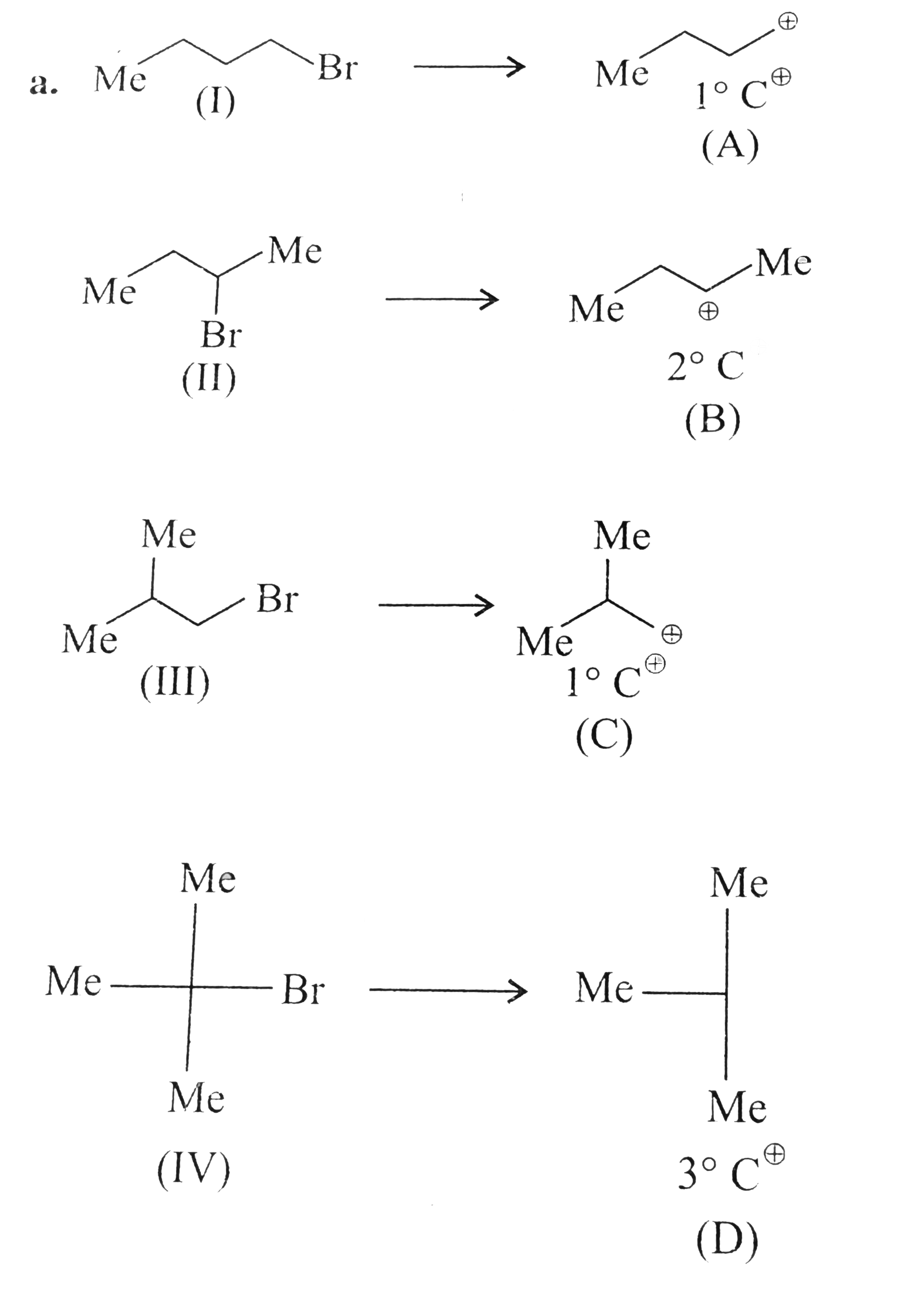Predict the order of reactivity of the folloiwing compoundss in SN1 and SN2 reacations.
a. The four isomeric bromolbutanes
b. I. C6H5CH2Br
II. C6H5CH(C6H5)Br
III. C6H5CH(CH3Br
IV. C6H5C(CH3(C6H5)Br
a. 
Out of 1∘C⊕(A) and (C),(C) is more stable due to +I effect of two (Me) groups. Therefore, (III) is more reactive than (I) in SN1 reaction.
SN1⇒)I)>(III)>(II)>(IV)
SN2⇒(I)>(III)>(II)>(IV)
b. SN1⇒C6H5C(CH3)(C6H5)Br(IV)
>C6H5CH(C96H5)−Br>C6H5CH(CH3)Br>C6H5CH2Br
>(II)>(III)>(I)
SN2⇒C6H5C(CH3)(C6H5)Br<C6H5CH(C6H5()−Br<
(IV)<(II)
C6H5CH(CH3)Br<C6H5H2Br
(III)<(I)
Of the two secondary bromides, the carbocation intermediate obtained from (II) is more stable than that obtained form (III) becuase it is stablised byu two phenyl groups due to resonacne. Therefore the foremer bormide is more reactive than the latter in SN−1 reacations. A phenyl group is bulkier than a methuyl group . THerefore (II0 is less reactive than (III) in SN2 reacations.
Topper's Solved these Questions
- AROMATIC COMPOUNDS AND ALKYL AND ARYL HALIDES BOOK - CENGAGE CHEMISTRYCHAPTER - AROMATIC COMPOUNDS AND ALKYL AND ARYL HALIDES EXERCISE - Exercises Subjective Type
4 Videos
- AROMATIC COMPOUNDS AND ALKYL AND ARYL HALIDES BOOK - CENGAGE CHEMISTRYCHAPTER - AROMATIC COMPOUNDS AND ALKYL AND ARYL HALIDES EXERCISE - Exercises Subjective
17 Videos
- AROMATIC COMPOUNDS AND ALKYL AND ARYL HALIDES BOOK - CENGAGE CHEMISTRYCHAPTER - AROMATIC COMPOUNDS AND ALKYL AND ARYL HALIDES EXERCISE - Solved Examples
21 Videos
- APPENDIX INORGANIC VOLUME 2BOOK - CENGAGE CHEMISTRYCHAPTER - APPENDIX INORGANIC VOLUME 2EXERCISE - Short Answer Type
179 Videos
- BIOMOLECULESBOOK - CENGAGE CHEMISTRYCHAPTER - BIOMOLECULESEXERCISE - Exercises Archives (Analytical And Descriptive)
8 Videos
Similar Questions
Predict the order of reactivity of the following compounds in SN1 and SN2 reactions :
(a) The four isomeric bromobutanes
(b) C6H5CH2Br,C6H5CH(C6H5)Br,C6H5CH(CH3)Br,C6H5C(CH3)(C6H5)Br
View SolutionPredict the order of reactivity of the following compounds in SN1 and SN2 reactions:
(i) The four isomeric bromobutanes
(ii) C6H5CH2Br,C6H5CH(C6H5)Br,C6H5CH(CH3)Br,C6H5C(CH3)(C6H5)Br
View Solution
Knowledge Check
The decreasing order of reactivity of the following compounds in SN1 reactions is _________.
(i) C6H5CH2Br (ii)C6H5CH(C6H5Br
(iii)C6H5CH(CH3Br (iv)C6H5C(CH3)(C6H5)BrA(i)>(ii)>(iii)>(iv)B(iv)>(iii)>(ii)>(i)C(iv)>(ii)>(iii)>(i)D(iii)>(ii)>(i)>(iv)The order of reactivity of the following compounds towards electrophilic substitution will be :
(I) C6H5CH3
(II) C6H5CH2CH3
(III) (C6H5CH(CH3)3
(IV) (C6H5C(CH3)3AI>II>III>IVBIV>III>II>ICII>I>III>IVDIII>II>I>IVC6H5CONHCH3 can be converted into C6H5CH2NHCH3 by .
ANaBH4BH2−Pd/CCLIAlH4DZn−Hg/HCl
Predict the order of reactivity of the following compounds in SN1 and SN2 reactions:
(i) The four isomeric bromobutanes
(ii) C6H5CH2Br,C6H5CH(C6H5)Br,C6H5CH(CH3)Br,C6H5C(CH3)(C6H5)Br
View SolutionEquivalent mass of the reaction
C6H5NO2→C6H5NH2.
View SolutionPredict the order of reactivity of the following compounds in S1NandS2N reactions:
C6H5CH2Br.C6H5CH(C6H5)Br,
C6H5CH.(CH3)Br,C6H5C.(CH3).(C6H5)Br.
View SolutionC6H5CONHCH3 can be converted into C6H5CH2NHCH3 by .
View SolutionC6H5CONHCH3 can be converted into C6H5CH2NHCH3 by .
View Solution
